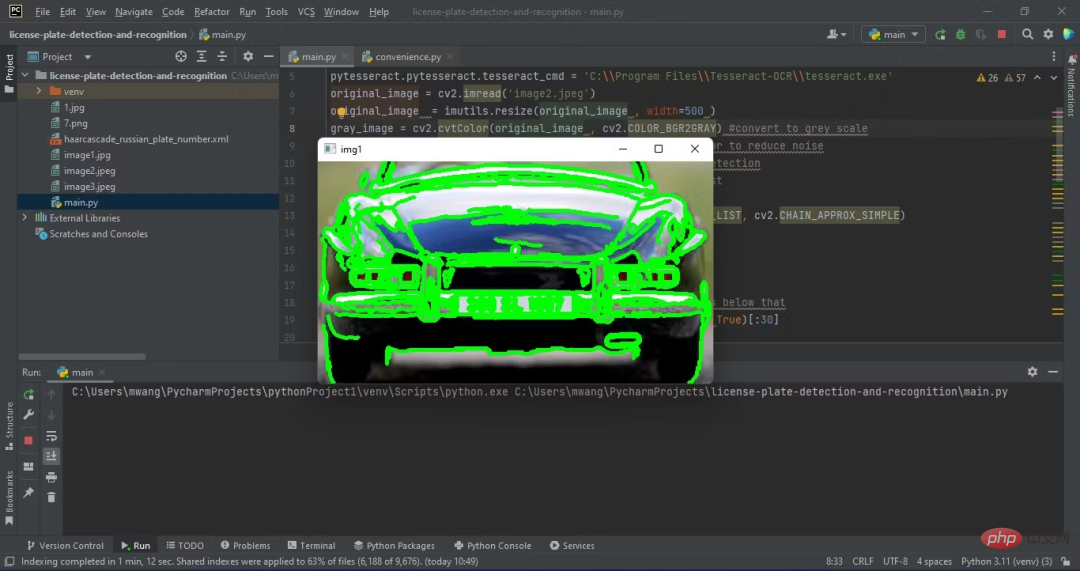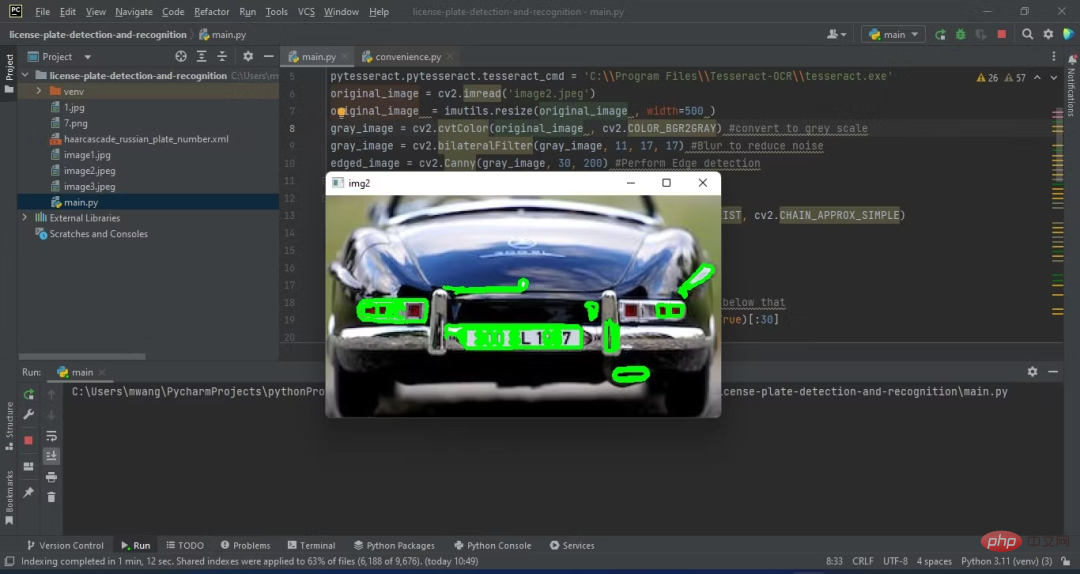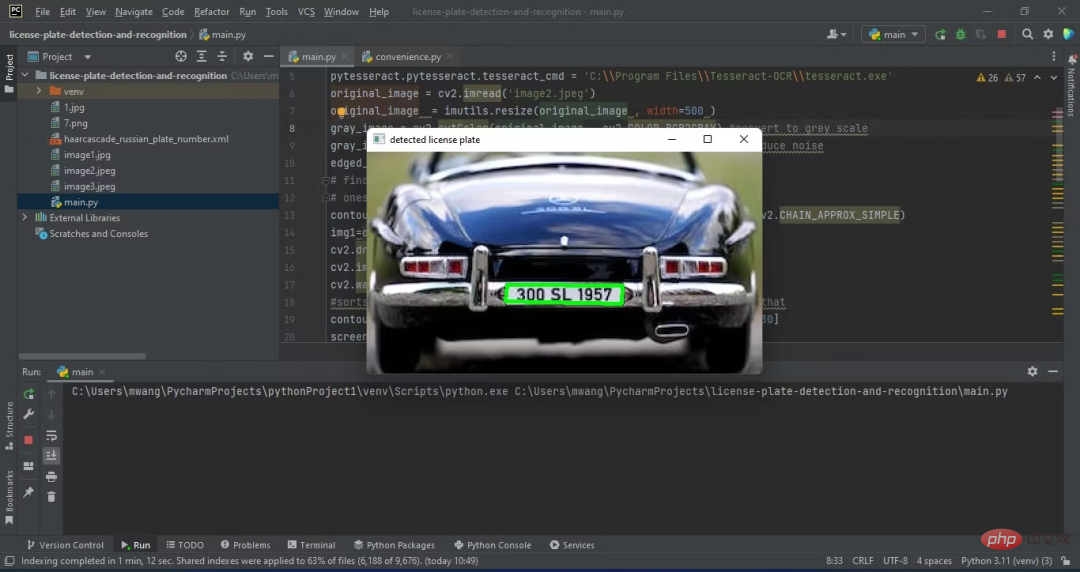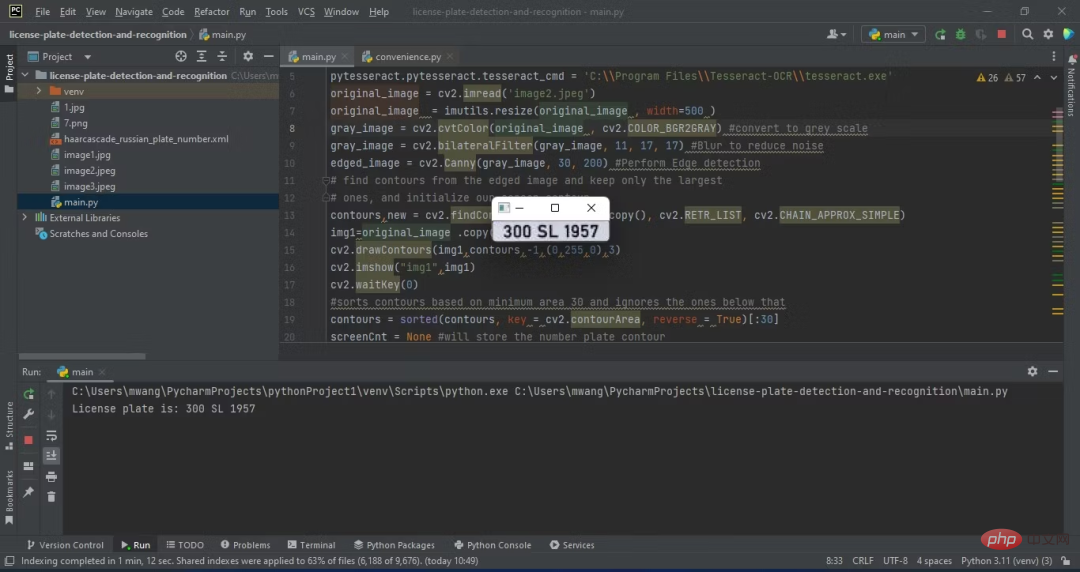How to detect and recognize license plates using Python?
Translator|Bugatti
Reviewer|Sun Shujuan
License plate detection and recognition technology is widely used and can be used in road systems, ticketless parking lots, Vehicle access control, etc. This technology combines computer vision and artificial intelligence.
This article will use Python to create a license plate detection and recognition program. The program processes the input image, detects and recognizes the license plate, and finally displays the license plate characters as output.
1. Create a Python environment
To easily complete this tutorial, you need to be familiar with the basics of Python. The program environment should be created first.
Before you start programming, you need to install several libraries in your environment. Open any Python IDE and create a Python file. Run the command on the terminal to install the corresponding library. You should have Python PIP pre-installed on your computer.
- #OpenCV-Python: You will use this library to preprocess input images and display individual output images. pip install OpenCV-Python
- imutils: You will use this library to crop the original input image to the desired width. pip install imutils
- pytesseract: You will use this library to extract license plate characters and convert them into strings. pip install pytesseract The pytesseract library relies on the Tesseract OCR engine for character recognition.
2. How to install Tesseract OCR on your computer?
Tesseract OCR is an engine that can recognize language characters. Before using the pytesseract library, you should install it on your computer. Here are the steps:
#1. Open any Chrome-based browser.
2. Download the Tesseract OCR installer.
3. Run the installer and install it like any other program.
After preparing the environment and installing tesseract OCR, you can write your program.
1. Import the library
First import the library installed in the environment. Importing libraries allows you to call and use their functions in your project.
- import cv2
- import imutils
- import pytesseract
You need Import the OpenCV-Python library in cv2 form. Import other libraries using the same names as when installed.
2. Get the input
and point pytesseract to the location where the Tesseract engine is installed. Use the cv2.imread function to take the car image as input. Replace the image name with the name of the image you are using. Store images in the same folder as your project for ease of use.
pytesseract.pytesseract.tesseract_cmd = 'C:\Program Files\Tesseract-OCR\tesseract.exe'
original_image = cv2.imread('image3.jpeg')You can replace the input image below with the image you want to use.
3. Preprocess the input
Adjust the image width to 500 pixels and then convert the image to grayscale because of canny edge detection Function only works on grayscale images. Finally, the bilateralFilter function is called to reduce image noise.
original_image = imutils.resize(original_image, width=500 ) gray_image = cv2.cvtColor(original_image, cv2.COLOR_BGR2GRAY) gray_image = cv2.bilateralFilter(gray_image, 11, 17, 17)
4. Detect the license plate at the input end
Detecting the license plate is the process of determining the part of the car that has the license plate characters.
(1) Perform edge detection
First call the cv2.Canny function, which can automatically detect preprocessing edges on the image.
edged_image = cv2.Canny(gray_image, 30,200)
We will find the outline through these edges.
(2) Find contours
Call the cv2.findContours function and pass a copy of the edge image. This function will detect contours. Use the cv2.drawContours function to draw the detected contours on the original image. Finally, output the original image with all visible contours drawn.
contours, new = cv2.findContours(edged_image.copy(), cv2.RETR_LIST, cv2.CHAIN_APPROX_SIMPLE)
img1 = original_image.copy()
cv2.drawContours(img1, contours, -1, (0, 255, 0), 3)
cv2.imshow("img1", img1)The program draws all the contours it finds on the car image.

After you find the contours, you need to filter them to identify the best candidate contours.
(3) Filter contours
Filter the contours based on the minimum area of 30. Outlines smaller than this area are ignored as they are unlikely to be license plate outlines. Make a copy of the original image and draw the first 30 contours on the image. Finally, the image is displayed.
contours = sorted(contours, key = cv2.contourArea, reverse = True)[:30]
# stores the license plate contour
screenCnt = None
img2 = original_image.copy()
# draws top 30 contours
cv2.drawContours(img2, contours, -1, (0, 255, 0), 3)
cv2.imshow("img2", img2)The number of outlines is now less than at the beginning. The only contours drawn are those that approximately contain the license plate.

Finally, you need to iterate through the filtered outlines and determine which one is the license plate.
(4) Traverse the first 30 contours
Create a for loop that traverses the contours. Find a contour with four corners and determine its perimeter and coordinates. Store an image containing the outline of a license plate. Finally, the license plate outline is drawn on the original image and displayed.
count = 0
idx = 7
for c in contours:
# approximate the license plate contour
contour_perimeter = cv2.arcLength(c, True)
approx = cv2.approxPolyDP(c, 0.018 * contour_perimeter, True)
# Look for contours with 4 corners
if len(approx) == 4:
screenCnt = approx
# find the coordinates of the license plate contour
x, y, w, h = cv2.boundingRect(c)
new_img = original_image [ y: y + h, x: x + w]
# stores the new image
cv2.imwrite('./'+str(idx)+'.png',new_img)
idx += 1
break
# draws the license plate contour on original image
cv2.drawContours(original_image , [screenCnt], -1, (0, 255, 0), 3)
cv2.imshow("detected license plate", original_image )After the loop, the program has identified the outline containing the license plate.

5.识别检测到的车牌
识别车牌意味着读取已裁剪车牌图像上的字符。加载之前存储的车牌图像并显示它。然后,调用pytesseract.image_to_string函数,传递已裁剪的车牌图像。这个函数将图像中的字符转换成字符串。
# filename of the cropped license plate image
cropped_License_Plate = './7.png'
cv2.imshow("cropped license plate", cv2.imread(cropped_License_Plate))
# converts the license plate characters to string
text = pytesseract.image_to_string(cropped_License_Plate, lang='eng')已裁剪的车牌如下所示。上面的字符将是您稍后在屏幕上输出的内容。

检测并识别车牌之后,您就可以显示输出了。
6.显示输出
这是最后一步。您将提取的文本输出到屏幕上。该文本含有车牌字符。
print("License plate is:", text)
cv2.waitKey(0)
cv2.destroyAllWindows()程序的预期输出应该如下图所示:

车牌文本可以在终端上看到。
三、磨砺您的Python技能
用Python检测和识别车牌是一个有意思的项目。它有挑战性,所以应该会帮助您学到关于Python的更多知识。
说到编程,实际运用是掌握一门语言的关键。为了锻炼技能,您需要开发有意思的项目。
原文链接:https://www.makeuseof.com/python-car-license-plates-detect-and-recognize/
The above is the detailed content of How to detect and recognize license plates using Python?. For more information, please follow other related articles on the PHP Chinese website!

Hot AI Tools

Undresser.AI Undress
AI-powered app for creating realistic nude photos

AI Clothes Remover
Online AI tool for removing clothes from photos.

Undress AI Tool
Undress images for free

Clothoff.io
AI clothes remover

Video Face Swap
Swap faces in any video effortlessly with our completely free AI face swap tool!

Hot Article

Hot Tools

Notepad++7.3.1
Easy-to-use and free code editor

SublimeText3 Chinese version
Chinese version, very easy to use

Zend Studio 13.0.1
Powerful PHP integrated development environment

Dreamweaver CS6
Visual web development tools

SublimeText3 Mac version
God-level code editing software (SublimeText3)

Hot Topics
 PHP and Python: Different Paradigms Explained
Apr 18, 2025 am 12:26 AM
PHP and Python: Different Paradigms Explained
Apr 18, 2025 am 12:26 AM
PHP is mainly procedural programming, but also supports object-oriented programming (OOP); Python supports a variety of paradigms, including OOP, functional and procedural programming. PHP is suitable for web development, and Python is suitable for a variety of applications such as data analysis and machine learning.
 Choosing Between PHP and Python: A Guide
Apr 18, 2025 am 12:24 AM
Choosing Between PHP and Python: A Guide
Apr 18, 2025 am 12:24 AM
PHP is suitable for web development and rapid prototyping, and Python is suitable for data science and machine learning. 1.PHP is used for dynamic web development, with simple syntax and suitable for rapid development. 2. Python has concise syntax, is suitable for multiple fields, and has a strong library ecosystem.
 PHP and Python: A Deep Dive into Their History
Apr 18, 2025 am 12:25 AM
PHP and Python: A Deep Dive into Their History
Apr 18, 2025 am 12:25 AM
PHP originated in 1994 and was developed by RasmusLerdorf. It was originally used to track website visitors and gradually evolved into a server-side scripting language and was widely used in web development. Python was developed by Guidovan Rossum in the late 1980s and was first released in 1991. It emphasizes code readability and simplicity, and is suitable for scientific computing, data analysis and other fields.
 Python vs. JavaScript: The Learning Curve and Ease of Use
Apr 16, 2025 am 12:12 AM
Python vs. JavaScript: The Learning Curve and Ease of Use
Apr 16, 2025 am 12:12 AM
Python is more suitable for beginners, with a smooth learning curve and concise syntax; JavaScript is suitable for front-end development, with a steep learning curve and flexible syntax. 1. Python syntax is intuitive and suitable for data science and back-end development. 2. JavaScript is flexible and widely used in front-end and server-side programming.
 Can vs code run in Windows 8
Apr 15, 2025 pm 07:24 PM
Can vs code run in Windows 8
Apr 15, 2025 pm 07:24 PM
VS Code can run on Windows 8, but the experience may not be great. First make sure the system has been updated to the latest patch, then download the VS Code installation package that matches the system architecture and install it as prompted. After installation, be aware that some extensions may be incompatible with Windows 8 and need to look for alternative extensions or use newer Windows systems in a virtual machine. Install the necessary extensions to check whether they work properly. Although VS Code is feasible on Windows 8, it is recommended to upgrade to a newer Windows system for a better development experience and security.
 How to run sublime code python
Apr 16, 2025 am 08:48 AM
How to run sublime code python
Apr 16, 2025 am 08:48 AM
To run Python code in Sublime Text, you need to install the Python plug-in first, then create a .py file and write the code, and finally press Ctrl B to run the code, and the output will be displayed in the console.
 Can visual studio code be used in python
Apr 15, 2025 pm 08:18 PM
Can visual studio code be used in python
Apr 15, 2025 pm 08:18 PM
VS Code can be used to write Python and provides many features that make it an ideal tool for developing Python applications. It allows users to: install Python extensions to get functions such as code completion, syntax highlighting, and debugging. Use the debugger to track code step by step, find and fix errors. Integrate Git for version control. Use code formatting tools to maintain code consistency. Use the Linting tool to spot potential problems ahead of time.
 Where to write code in vscode
Apr 15, 2025 pm 09:54 PM
Where to write code in vscode
Apr 15, 2025 pm 09:54 PM
Writing code in Visual Studio Code (VSCode) is simple and easy to use. Just install VSCode, create a project, select a language, create a file, write code, save and run it. The advantages of VSCode include cross-platform, free and open source, powerful features, rich extensions, and lightweight and fast.






